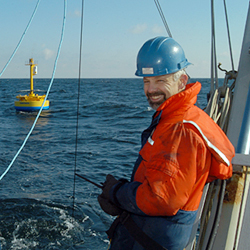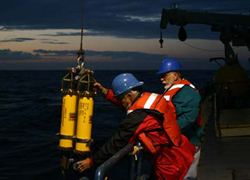Local Time: 1005 Local Time
Position: 54 32.9ºN, 54 33.3ºW
Weather: Rain; Wind speed 25 knots
Sea state: 6-8 feet seas
Air temperature: 41.7ºF, 5.4ºC
Sea Surface temperature: 36.7ºF, 2.6ºC
Breakfast: Blueberry pancakes and fruit salad
Today's Audio Postcards (mp3 format)
» Deck Boss Will Ostrom tests an Acoustic Release
Today's Journal
What a difference a day makes! During the night, we left our cozy “inland passage” through the Straits of Belle Isle (between Newfoundland and Labrador) and entered the open ocean. The weather, and the temperature, went downhill fast. We now have a cold, windy rain. The wind is much stronger than anything so far on the trip, but fortunately, the wind and waves ard coming from behind us so the ride is still relatively comfortable—just a gentle roll from side to side.
Notice the latitude and longitude? They are almost exactly the same. There are many points on the earth that have this property, but I can’t say I’ve ever visited one...a bit of geographic trivia!
Notice also the very low sea surface temperature. This indicates that we are in the Labrador Current, a current that flows southward in this area, carrying very cold water from the Arctic. It flows quite close to the coast, so I’m thinking that as we get farther out into the middle of the Labrador Sea, the ocean temperature will go back up.
Everyone on board is getting restless to do something scientific. And today we will finally get our feet wet. At about 1600 (that’s 4:00 PM local time), we will stop the ship to test some equipment. First we will test the mooring’s acoustic release. The release is one of the most important pieces of gear on the mooring. It is mounted on the mooring wire near the bottom. When we come back to retrieve the mooring, we will send a special sound signal from the ship to the release telling it to let go of the anchor. It will then open a clasp holding the mooring wire, and the buoyant sphere will bring all the instruments up to the surface. We will then drive the ship to the gear and haul it on board.
If the release doesn’t let go for some reason, we might never get the mooring and its sensors back. That’s why it’s very important to test the release before deploying the mooring. We will do that by lowering the release on a wire from the ship, send some sound signals, and check that the release replies correctly.



